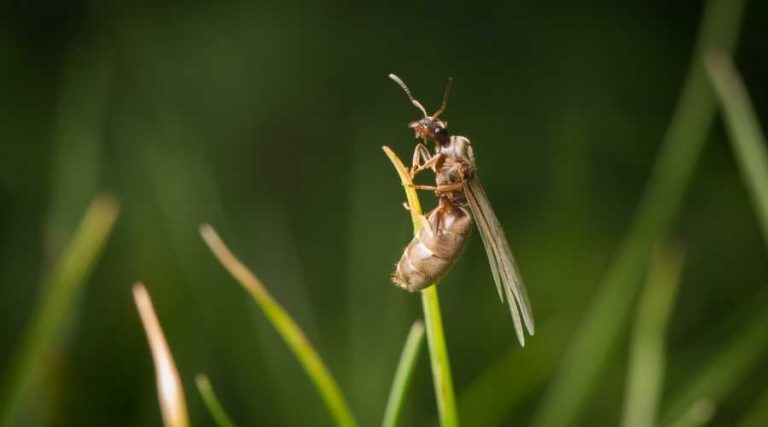Have you spotted an ant with wings? Perhaps you have seen several and are wondering, since when could ants fly? Well, they have been able to fly since time immemorial. Several ant species have a type of ant known as a swarmer or alate. This flying ant can either be male or female. The main responsibility of the swarmers is to copulate and later fly off to start a new colony. An alate is not a different breed but rather an ant that has developed wings with the sole intention of mating.
The Interesting Nuptial Flight
You will often see an ant carrying what looks like food and pushing it into a nest. This is a worker ant and in any given colony there may be over 5000 of them. These workers are all female. They work to feed their queen whose sole purpose is to lay eggs and make new family members. A worker will only live for about a month while a queen can live for up to 10 years.
At an appropriate time, usually on a clear day after rains, a flying ant or several will be seen. In such a swarm you will find new queens and males. They fly in what is known as the ‘nuptial flight’. The queens are slightly bigger than the males. The new queens and flying males mate during flight.
The new queens then lose their wings and start crawling in an attempt to find new nesting ground. The males only live for a maximum of two days after the nuptial flight. The queens will then make an underground nest where they lay eggs which creates workers. The workers provide food for the queen and when the time is right, new queens and males will be created and the cycle continues.
When Will You See These Insects?
While there is no specific day when this may happen, some favorable conditions are needed. Bright sunlight, high humidity, and low wind are some of the desired requirements. This is why summer and spring are the most likely reasons for the nuptial flight.
It is rare to see a single flying ant. A large swarm will likely face you. This has been associated with increasing the chances of copulation. The good thing is that the flights last a day or a few. The many insects coming out to mate quickly is such a spectacle. In the UK, so many ants are seen in a day that they have what is loosely called ‘Flying Ant Day’ every year.
The flying ant is not a dangerous insect. The only thing on its head is mating; stinging is the last thing they want to do. However, if their crawling counterparts bite or sting, the alates will do the same if threatened. Also, flying ant day attracts birds like seagulls that snack on these insects. These are the top reasons you may want to eliminate the flying ant.
How to Get Rid of Flying Ants
There are several methods that you may use to get rid of these insects from your home including:
- Vacuuming: Use a vacuum cleaner to suck up the insects and then replace the vacuum bag immediately.
- Using Sticky Tape: Place sticky tape that is normally used to catch flying insects in a strategic place. Every ant that comes around will be stuck to the tape and can be later disposed of.
- Spray Them with Dishwashing Soap: Dishwashing soap will dehydrate a flying ant and make it immobile. Mix a small amount of dishwashing soap with water and spray the insects as they fly around. You may add a few drops of peppermint oil to this spray which suffocates and kills the insects.
- Borax Sprays: Any insecticide spray that contains borax is ideal in getting rid of ant colonies. This insecticide will not kill the ant on the spot. Instead, the ant will carry it back to its nest and spread to others which may help eradicate an entire colony.
- Seal Cracks & Keep Openings Closed: The flying only lasts a few days at most. Keeping doors and windows closed during this time will ensure that the insects do not fly into your home. Cracks should be sealed so as to avoid these and other insects from coming in.
Prevent Future Attacks
If you see huge swarms it is likely that there is an anthill nearby. You need to get that dealt with or you will have the same problem every year. To remove an anthill you will need professional services. You may try and spot the anthill on your own but if you are unable to (but have many ants flying around), call professionals to help find and exterminate the nest.

